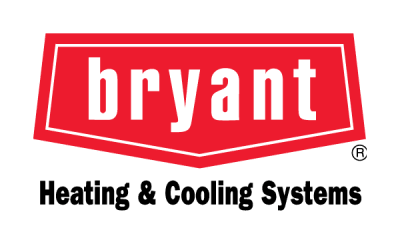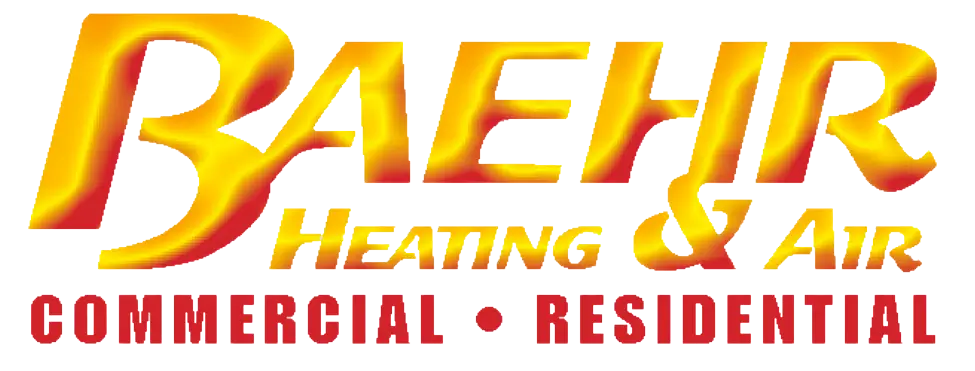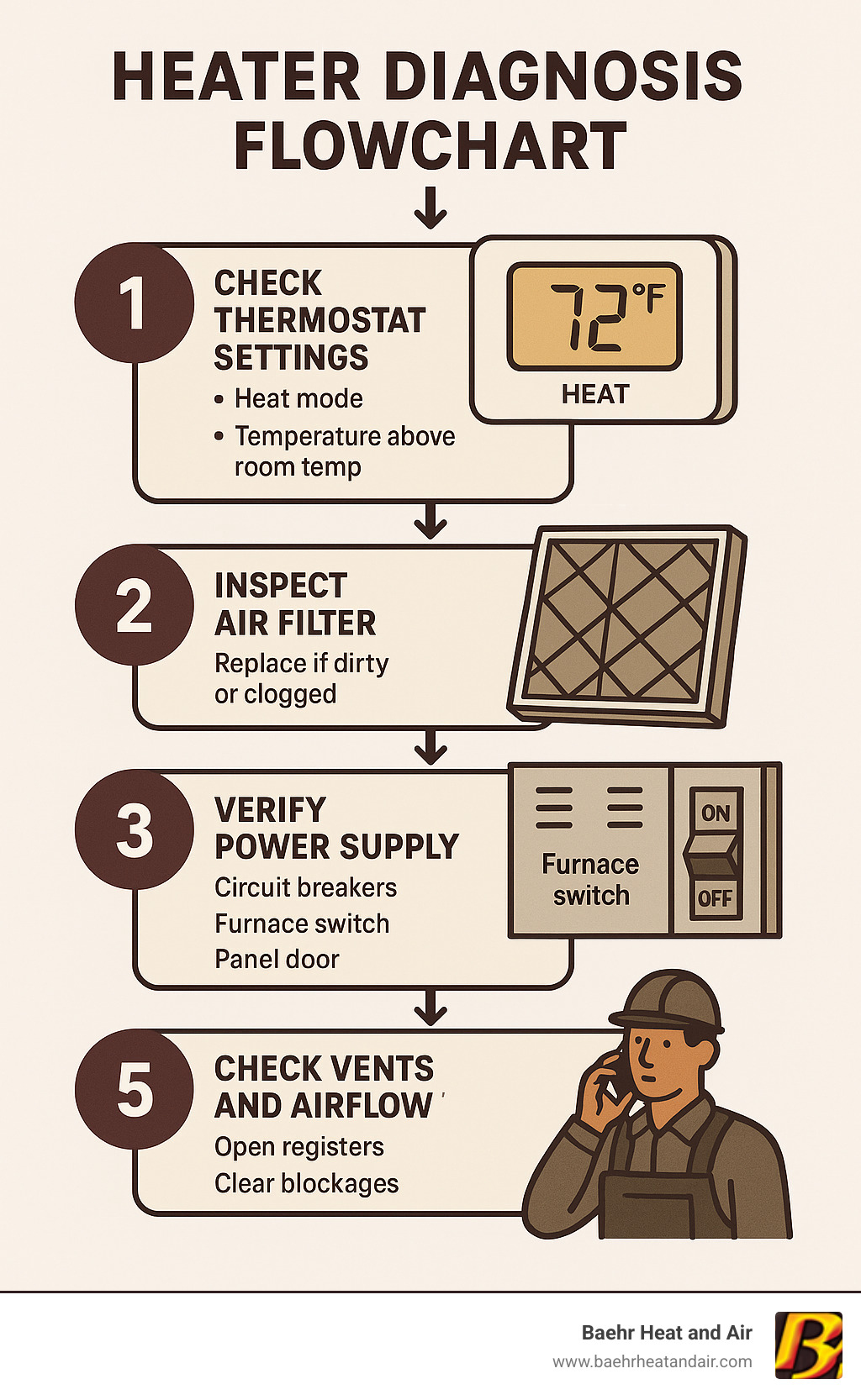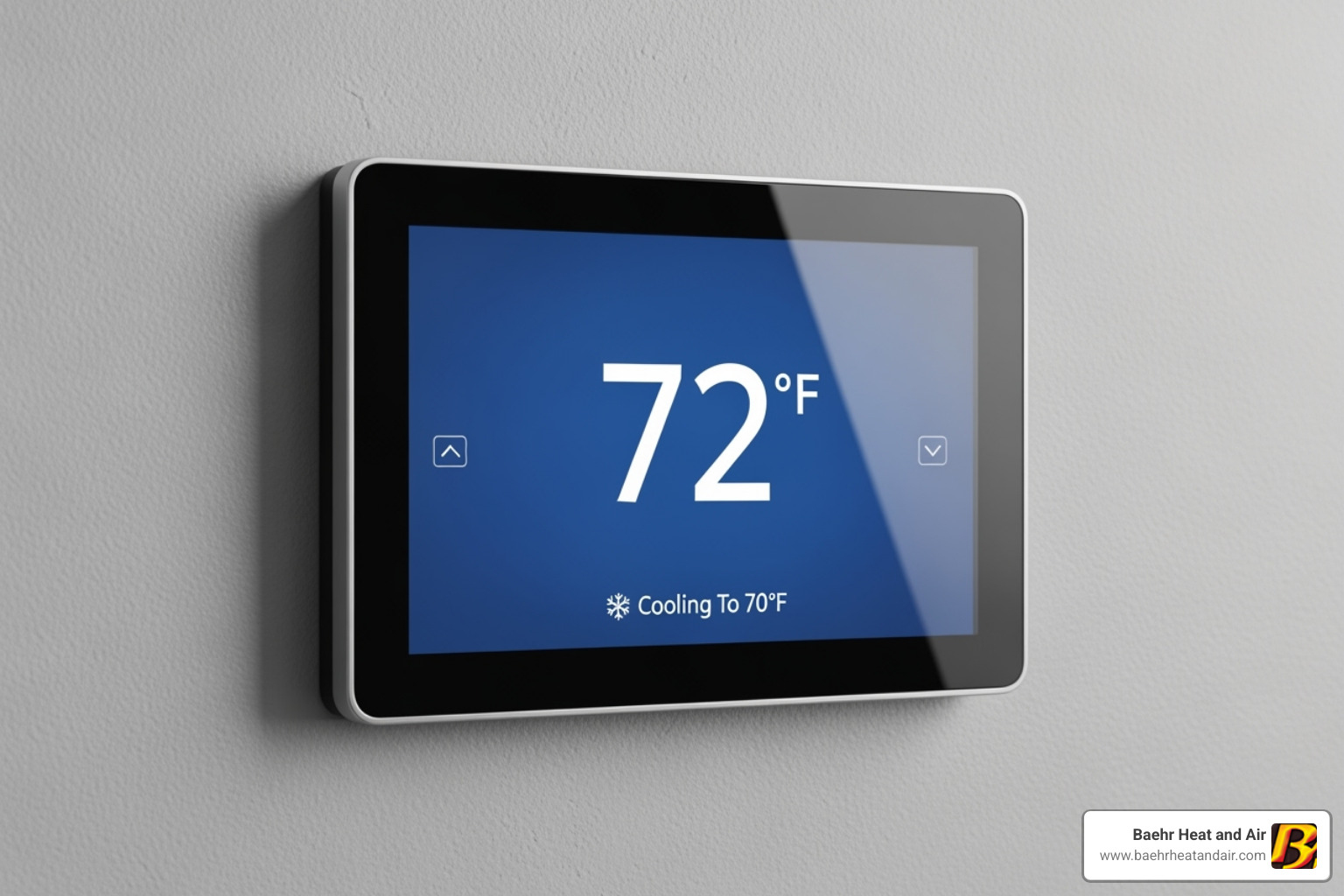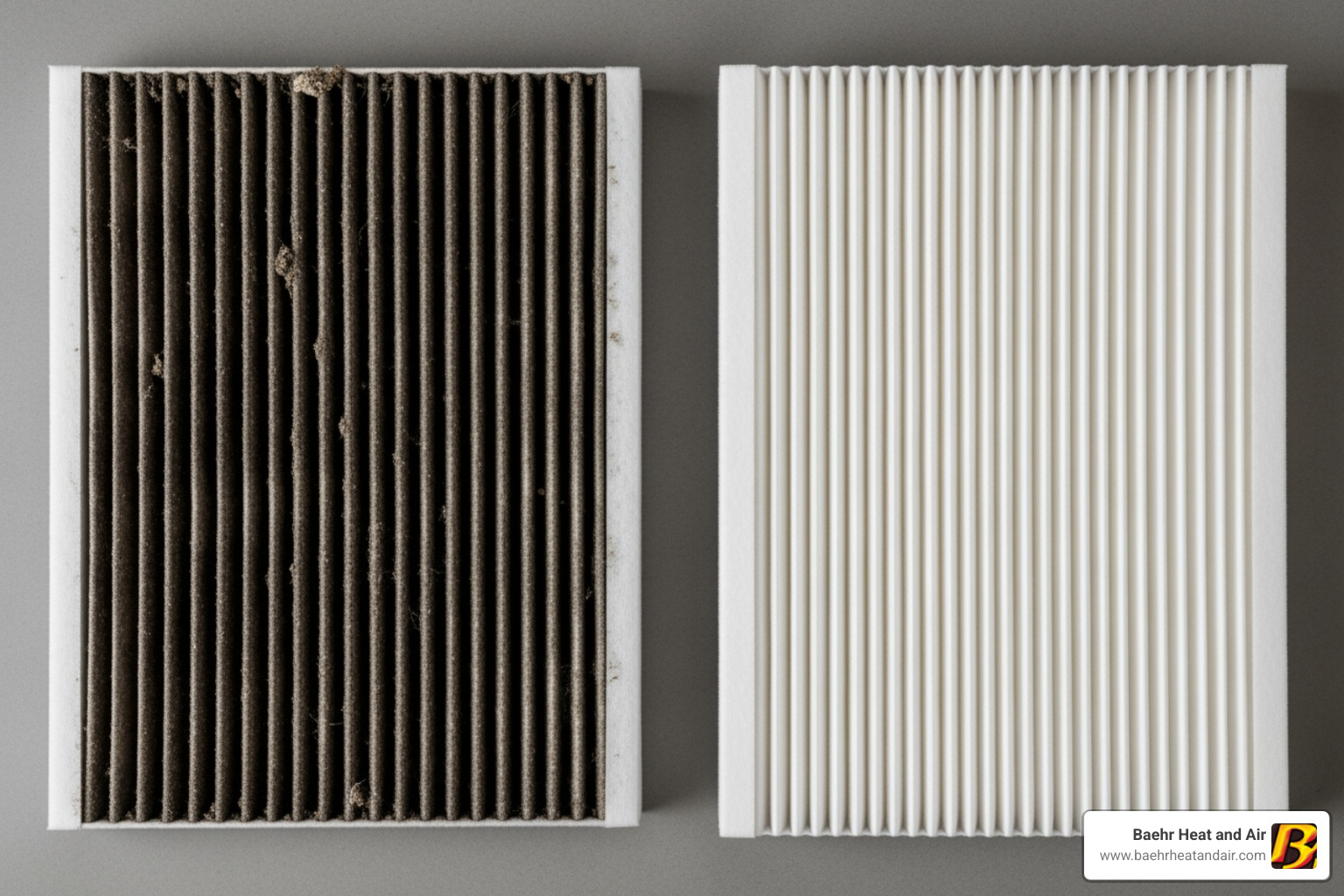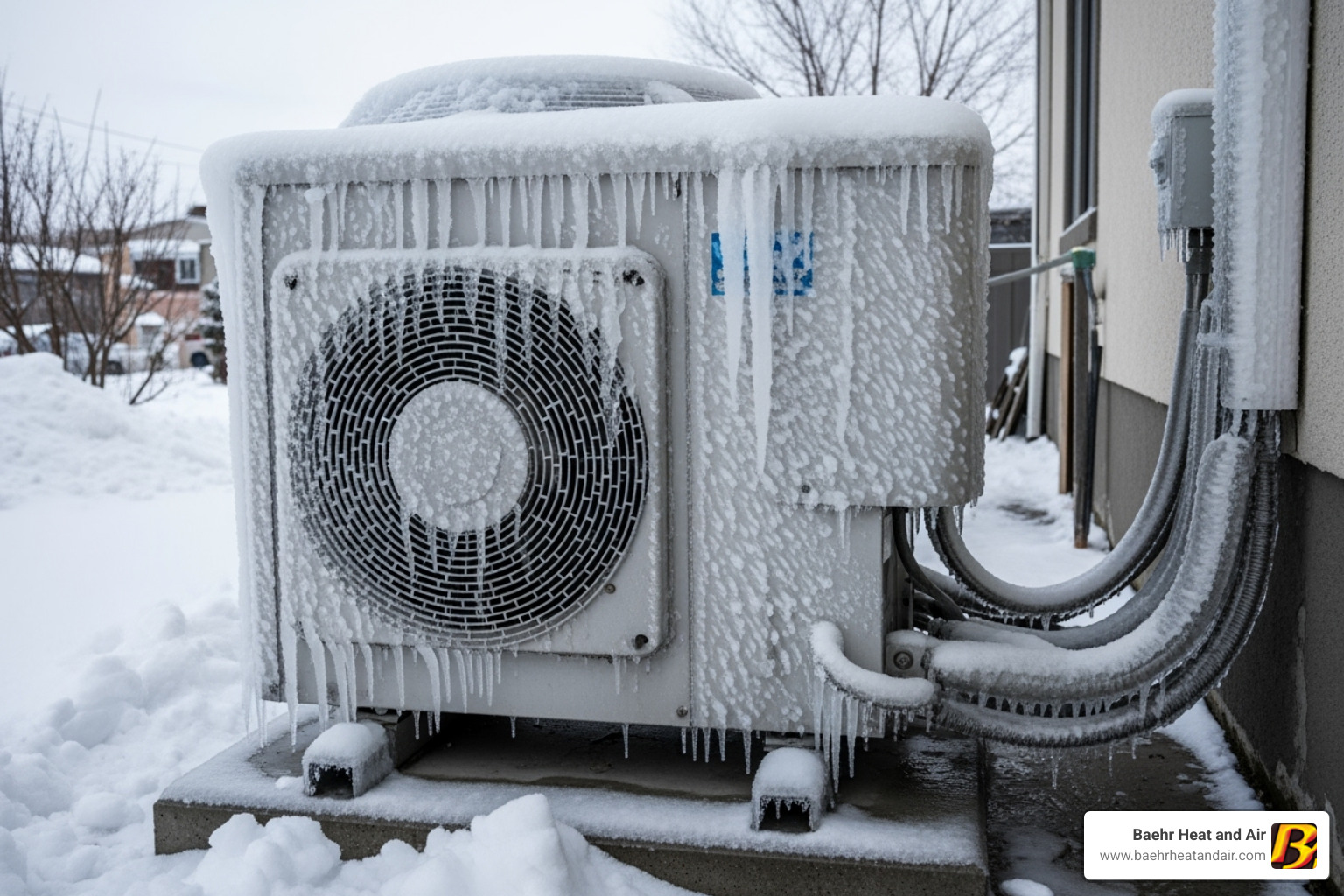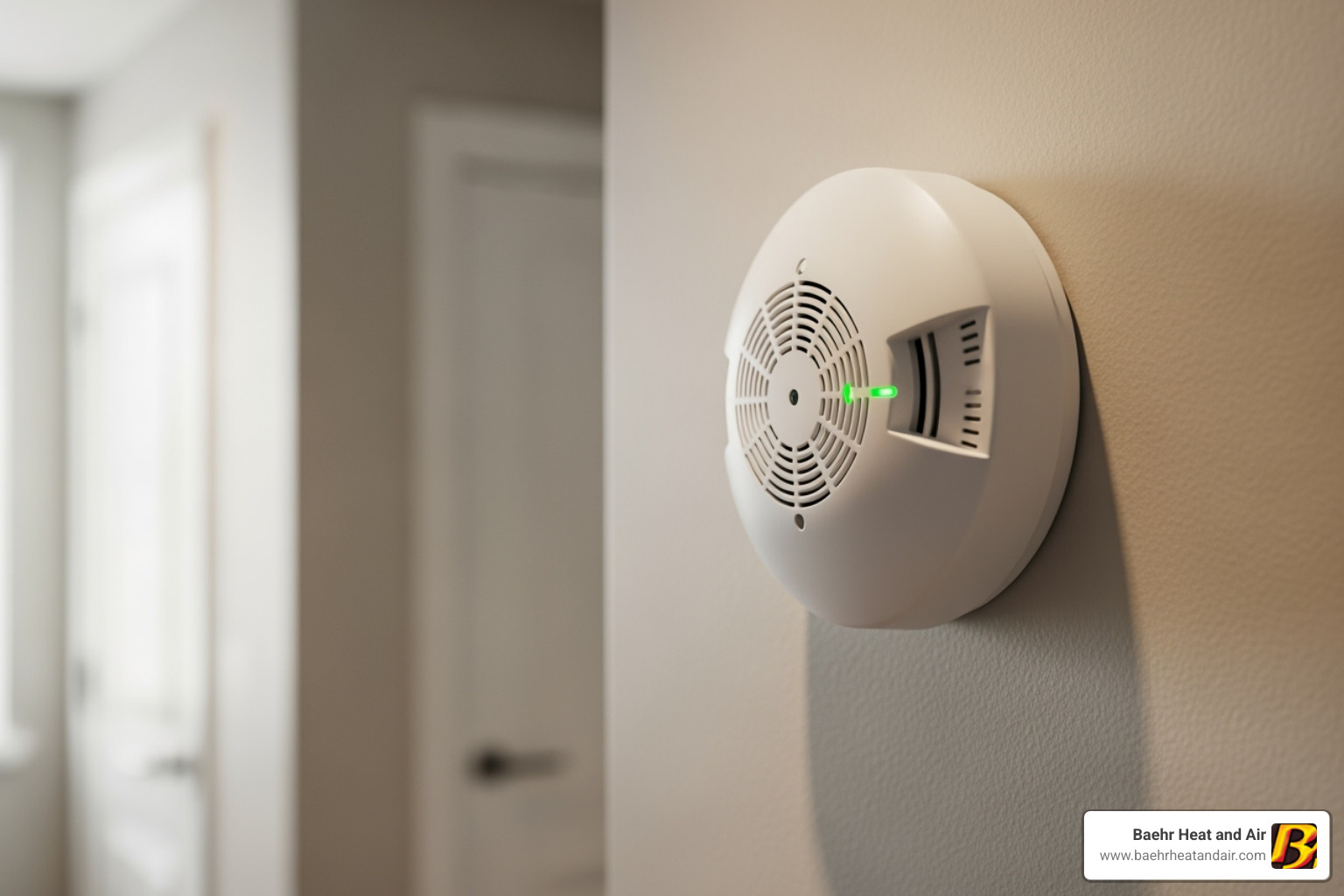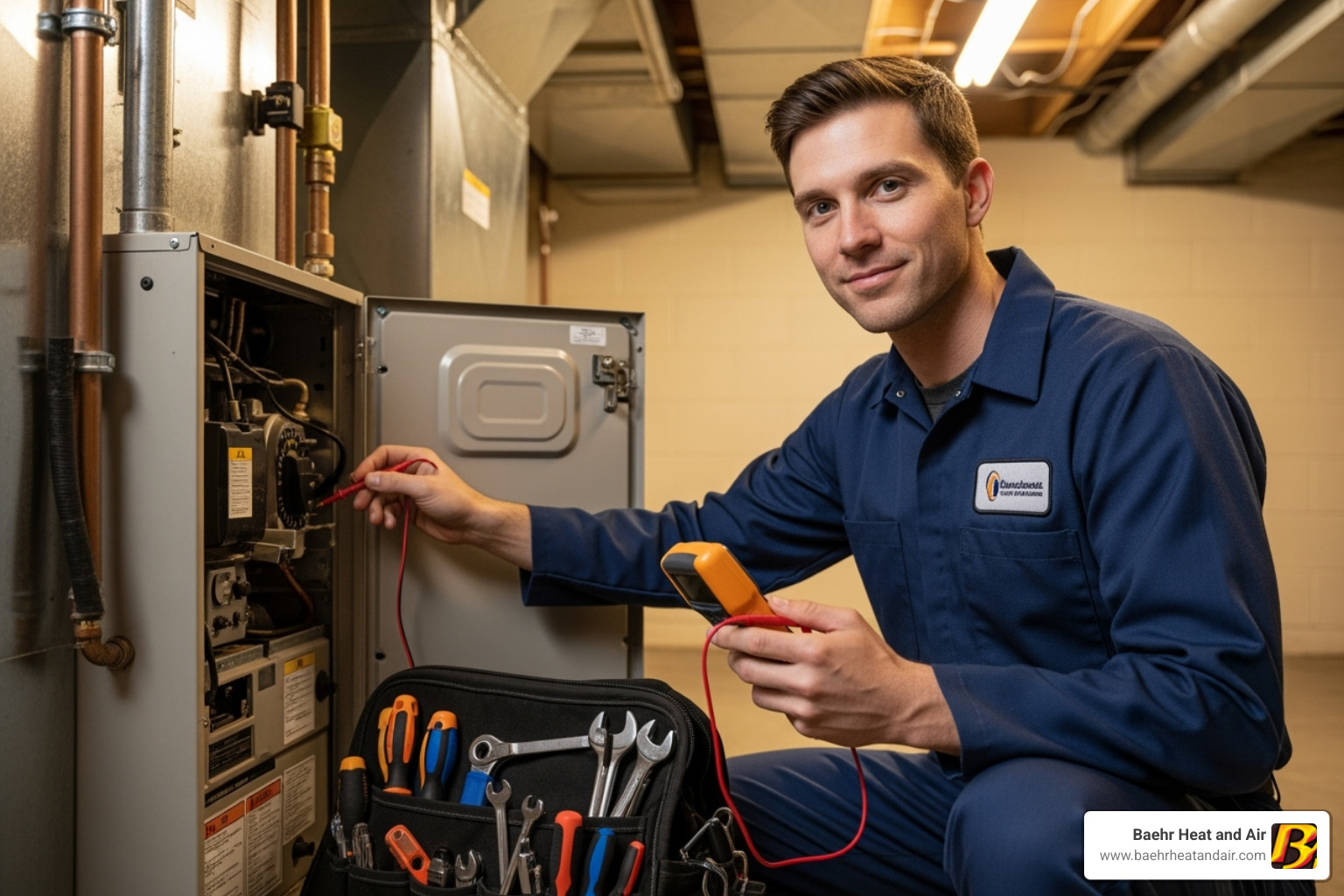When Your Heating System Broken Leaves You Shivering
When your heating system broken leaves you shivering during a cold Grass Valley winter, you need answers fast. Here’s what to check immediately:
Quick Heating System Diagnosis:
- Check thermostat – Set to “heat” and temperature 5° above room temp
- Inspect air filter – Replace if clogged or dirty
- Verify power – Check circuit breakers and furnace switch
- Examine vents – Ensure they’re open and unblocked
- Call professional – If these steps don’t restore heat
When your heating system fails, it’s not just about comfort. According to the National Fire Protection Association, heating equipment is a factor in 14% of all reported home fires, making timely repairs crucial for safety.
The good news is that many heating problems have simple solutions. Issues like incorrect thermostat settings, clogged air filters, or tripped circuit breakers are common culprits that you can often fix yourself in minutes. However, it’s just as important to know when to stop and call a professional. Problems involving gas leaks, electrical faults, or carbon monoxide risks require immediate expert attention for your safety.
What to Do When Your Heating System is Broken: First Steps for Homeowners
When you find your heating system broken on a cold morning, don’t panic. Many issues have simple solutions you can handle yourself. Before calling for service, walk through these basic troubleshooting steps.
Check Your Thermostat Settings
Your thermostat controls your heating system, and it’s often the source of the problem.
- Set to “Heat” Mode: It’s easy for this setting to be accidentally switched to “Cool” or “Off.”
- Raise the Temperature: Set the temperature at least 5 degrees higher than the current room temperature to signal the system to turn on.
- Check Batteries: A blank screen on a digital thermostat usually means it needs fresh batteries.
- Consider Placement: If your thermostat is near a draft or a heat source (like a TV), it can get inaccurate readings, causing your system to cycle improperly.
If you have a smart thermostat, a simple restart can often resolve glitches. For more insights, see these common heater problems.
Inspect Your Air Filter
A dirty air filter is one of the most common reasons a heating system broken down occurs. It restricts airflow, forcing your furnace to work harder, which can cause it to overheat and shut down as a safety precaution.
To check your filter, turn off your system, locate the filter slot, and pull it out. If you can’t see light through it, it’s time for a replacement. As a rule, change your filter every 1-3 months, or more often if you have pets or allergies. This simple task can prevent major repairs. Here’s a guide on how to change your air filter if you need help.
Troubleshooting a Heating System Broken Due to Power Issues
Sometimes, the problem is simply a lack of power. Even gas furnaces need electricity to run.
- Check the Circuit Breaker: Find the breaker for your “Furnace” or “HVAC” and see if it has tripped. If so, switch it fully off, then back on. If it trips again, call a professional.
- Find the Power Switch: There is usually a power switch on or near the furnace unit itself. Make sure it hasn’t been accidentally turned off.
- Check the Panel Door: Most furnaces have a safety switch that prevents operation if the panel door isn’t securely closed. Give it a firm push to ensure it’s latched.
If these steps don’t work, it’s time for professional help. You can learn more on our Furnace Repair 101 page.
Diagnosing Your Specific Heating System: Furnace vs. Heat Pump
Not all heating systems are the same. In Grass Valley, Nevada City, and North Auburn, we primarily see gas furnaces and heat pumps. Diagnosing a heating system broken down requires knowing which type you have.
Gas Furnace vs. Heat Pump Troubleshooting
| Issue | Gas Furnace Check | Heat Pump Check |
|---|---|---|
| No Heat | Pilot light out, dirty flame sensor, gas valve closed | Outdoor unit not running, low refrigerant, defrost cycle issue |
| Blowing Cold Air | Clogged filter, ductwork leaks, fan setting on ‘ON’ | Defrost mode active, low refrigerant, outdoor unit iced over |
| Frequent Cycling | Dirty flame sensor, faulty thermostat, clogged filter | Incorrect sizing, refrigerant leak, thermostat issue |
Common Gas Furnace Problems
When your gas furnace is the source of your heating system broken issue, here are some specific things to look for.
- Pilot Light/Ignition Issues: On older units, the pilot light can go out. On newer furnaces, a dirty flame sensor is a common problem, causing the system to start and then shut down immediately because it can’t detect the flame.
- Gas Supply: Ensure the gas valve near your furnace is open.
- Cracked Heat Exchanger: This is a serious safety issue where carbon monoxide can leak into your home. Signs include a burning smell, soot near the furnace, or your CO detector alarming. If you suspect this, turn off the furnace and call a professional immediately.
For more details, visit our page on furnace repair in Grass Valley.
Common Heat Pump Problems
Heat pumps are versatile but have unique issues when they act as a heating system broken.
- Low Refrigerant: This often indicates a leak and prevents the heat pump from heating effectively. You might notice the outdoor unit icing over or the auxiliary heat running constantly.
- Frozen Coils: While some frost is normal, a completely iced-over outdoor unit points to a problem like low refrigerant, restricted airflow, or a malfunctioning defrost cycle.
- Reversing Valve Failure: This valve switches the unit between heating and cooling. If it fails, you might get cold air when you want heat.
- Auxiliary Heat Issues: In very cold weather, electric heating coils provide supplemental warmth. If your home isn’t getting warm enough, you can switch your thermostat to ‘Emergency Heat’ to test if these coils are working.
Learn more about these issues in our resource on Common Heater Repair Issues.
Warning Signs and Safety Concerns
Sometimes, your system gives warning signs before it fails completely. Recognizing these can keep you safe and prevent a heating system broken emergency.
Interpreting Strange Noises and Smells
Your heating system should run quietly. If you hear or smell any of the following, pay attention:
- Banging/Knocking: Could indicate a dangerous delayed gas ignition. Turn the system off and call for service.
- Grinding or Squealing: Often points to a problem with the blower motor or a worn belt.
- Whistling: Usually means air leaks in your ductwork.
- Buzzing: Can signal an electrical issue.
- Burning Smell: A brief dusty smell is normal at the start of the season. A persistent burning odor could mean overheating electrical parts. Shut the system down immediately.
Signs Your Heating System is Broken and Needs a Professional
Beyond strange sounds and smells, watch for these performance issues:
- Spiking Utility Bills: A sudden increase means your system is working inefficiently.
- Uneven Heating: Cold and hot spots in your home can indicate blocked vents, leaky ducts, or a failing blower.
- Short-Cycling: The system turns on and off frequently without completing a full cycle, causing excessive wear.
- Water Pooling: Leaks around your indoor unit can signal a clogged drain line or other issues.
Our guide on Shield Your Furnace from Winter Repairs: 5 Effective Preventive Measures can help you avoid these problems.
The #1 Safety Risk: Carbon Monoxide
While a cold house is an inconvenience, carbon monoxide (CO) is a deadly threat. This invisible, odorless gas is produced when fuel doesn’t burn completely in your furnace. A cracked heat exchanger can allow CO to leak into your home.
You cannot see, smell, or taste carbon monoxide. Early symptoms like headaches, dizziness, and nausea are often mistaken for the flu. This is why CO detectors are essential lifesavers.
Install CO detectors on every level of your home, especially near sleeping areas. If a detector alarms, evacuate everyone immediately, call 911, and do not re-enter until emergency services say it’s safe. Your family’s safety is paramount. For more information, see these Facts about this deadly gas from the CDC.
When to Stop Troubleshooting and Call a Professional
While DIY troubleshooting is great for simple issues, it’s crucial to know when a heating system broken problem requires an expert. Attempting complex repairs can be dangerous and lead to more expensive damage.
The Limits of DIY Repair
We encourage homeowners to check thermostats, filters, and breakers. However, you should always call a professional for:
- Complex Electrical Issues: Working with control boards, capacitors, or wiring requires specialized tools and knowledge to avoid electric shock.
- Refrigerant Leaks: Handling refrigerant requires certification and special equipment. It’s also an environmental hazard.
- Gas Line Problems: Any issue involving your gas supply is a serious safety risk and should only be handled by a licensed professional.
- Internal Component Replacement: Replacing motors or fans requires precise installation to avoid damaging the system.
If your basic checks don’t work, or if the problem involves gas, refrigerant, or complex wiring, it’s time to call us.
The Value of Professional Maintenance
Preventing problems is always better than fixing them. Regular professional maintenance is a smart investment for several reasons:
- Prevents Breakdowns: Technicians can spot and fix small issues before they become middle-of-the-night emergencies.
- Improves Efficiency: A clean, well-tuned system uses less energy, lowering your utility bills.
- Extends System Lifespan: Proper care helps you get the full 15-20 year lifespan out of your heating equipment.
- Ensures Safety: Maintenance includes vital safety checks, like inspecting the heat exchanger for cracks that could leak carbon monoxide.
At Baehr Heat and Air, we focus on quality and trust to ensure your lasting home comfort. Learn more about our heating service in Grass Valley and how we can help.
Frequently Asked Questions about Broken Heaters
When your heating system broken leaves you with questions, you’re not alone. Here are quick answers to the most common concerns we hear from homeowners in Grass Valley, Nevada City, and North Auburn.
Why is my heater blowing cold air?
This is a frustrating problem with several possible causes:
- Thermostat Fan Setting: Check if the fan is set to ‘On’ instead of ‘Auto.’ The ‘On’ setting makes the fan run constantly, even when the furnace isn’t heating.
- Overheating: A clogged filter can cause your furnace to overheat. A safety switch will shut off the burners but keep the fan running to cool the unit down, blowing cold air.
- Leaky Ductwork: Holes in your ducts can let cold air from an attic or crawlspace mix with the warm air.
- Heat Pump in Defrost Mode: It’s normal for a heat pump to briefly blow cooler air while it runs a defrost cycle in cold weather.
How do I know if my thermostat is the problem?
Before assuming your entire heating system broken, check for these thermostat warning signs:
- Blank Screen: The batteries are likely dead.
- Unresponsive Controls: The thermostat may be faulty.
- Incorrect Temperature Readings: The thermostat may be miscalibrated or poorly located.
- Short-Cycling: If the heater turns on and off constantly, the thermostat could be sending faulty signals.
Always try replacing the batteries and rebooting a smart thermostat before calling for service.
How often should I really change my air filter?
The standard advice is every 1-3 months, but it depends on your home. You should change it more frequently, likely monthly, if you have:
- Pets: Pet dander and hair clog filters quickly.
- Allergies or Asthma: A clean filter is crucial for maintaining good indoor air quality.
- A Dusty Environment: Living in a rural area or near construction can increase dust.
The best practice is to visually inspect your filter every month. If it looks dirty or you can’t see light through it, it’s time for a new one.
Don’t Stay in the Cold – Get Expert Help
When your heating system broken leaves you in the cold, you have the power to take the first steps. Remember to check your thermostat, air filter, and power supply. These simple checks can often solve the problem and restore warmth to your Grass Valley home.
However, it’s just as important to recognize when a problem is beyond a DIY fix. For strange noises, burning smells, or any safety concern like carbon monoxide, your family’s well-being comes first. Don’t hesitate to call a professional.
At Baehr Heat and Air, we’re committed to providing an outstanding customer experience with reliable, state-of-the-art solutions. We serve Grass Valley, Nevada City, and North Auburn with a focus on quality, trust, and saving you money for lasting home comfort.
Don’t let a broken heater disrupt your life. Whether you need an emergency repair or want to schedule preventive maintenance to avoid future problems, we’re here to help.
For expert HVAC repair in Auburn, CA, contact us today!. We’ll keep your home warm and your family safe all winter long.
